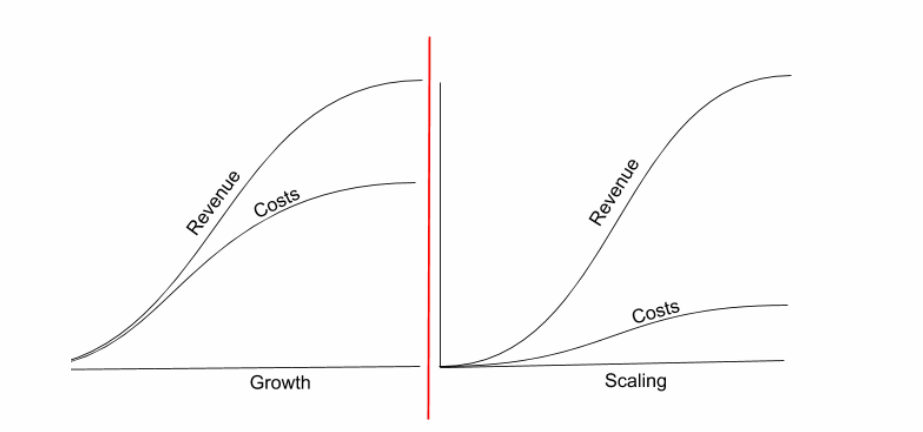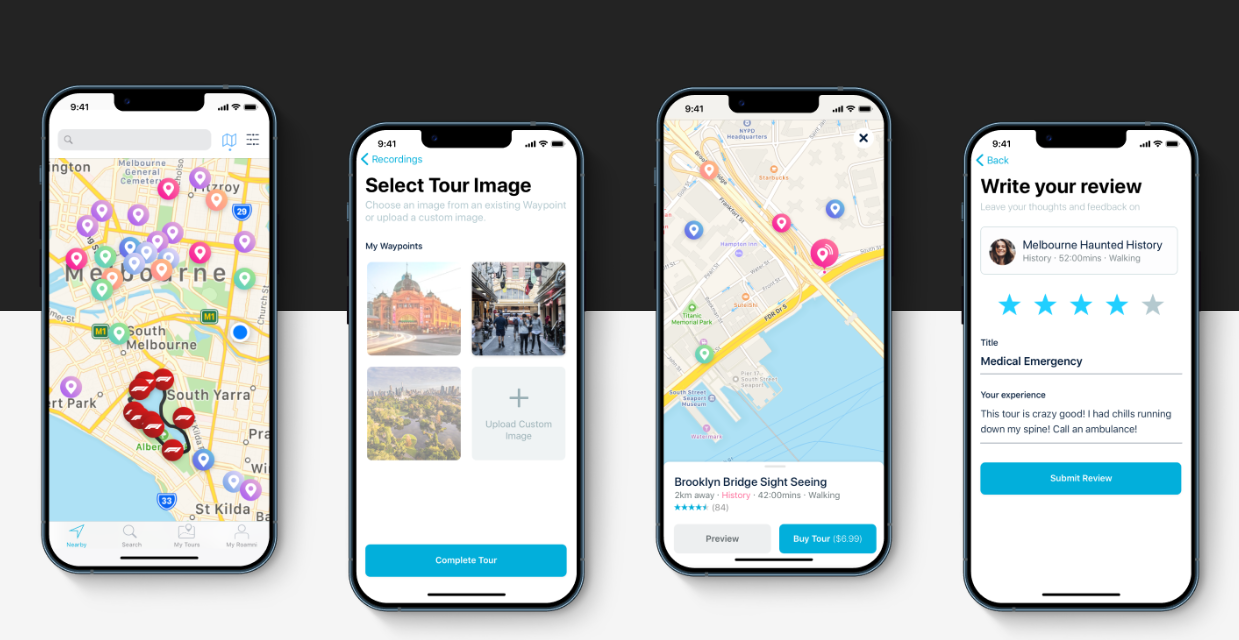Level Up Your Startup: The 3 Whens and Hows of Startup Scaling in 2025

You can’t afford to stand still in the fast-paced world of business.
Even big companies like Blockbuster died out due to their inability to grow.
The uncertainty of the global economy and international politics makes growth even more vital.
Cost-effectively growing your business is called scaling.
Ready to become the next startup scaling champ like Google or Amazon? I will explain in this article how you can successfully carry out startup scaling and perfectly time this move.
But first, let me explain what startup scaling is.
What is startup scaling?
Startup scaling is expanding a business by maximizing income at the least cost.
Business growth involves doing things like hiring more people or buying more assets to increase income. On the other hand, startup scaling tries to do the same through cost-saving technologies or other similar techniques.
The figure below shows how scaling and growth differ in terms of the gap between revenue and expenses.

Source: Ring Central
In scaling, innovative solutions ensure any of the following:
- Costs over time either decrease or remain constant
- Income increases exponentially
Examples of scaling solutions include better operational techniques and high-tech equipment. I will explain all these in the following sections.
Now that you know what startup scaling is and why it’s a good way forward, it’s time to learn when to scale your business.
3 Indicators Your Startup Is Due for Scaling
Most startups fail because they scale too soon.
But when conditions are right, scaling your startup business is a potential gold mine.
You know it’s the right time to scale when your business has:
- Earned and can potentially earn a decent amount of money
- Achieved meaningful goals
- Access to stable infrastructure
Let’s dig in and explore each of these in more detail.
Indicator 1: Healthy present and projected cash flow
A business scaling strategy doesn’t always come cheap despite its aim to earn more with less. For example, some high-tech solutions are expensive initially despite their long-term income-earning power.
That is why it is vital to have a war chest with which you can start waging the worthy struggle of scaling.
Check your income statements and balance sheets to see if you have enough funds for scaling. If your operating cash flow ratio is at least greater than 1, you have a good cash flow.
Another method to evaluate your war chest is checking your business’ product-market fit and customer loyalty. You will know these two things are within your grasp if you have a solid army of long-term buyers. Having these customers, in turn, tend to bring in good projected cash flow.
Indicator 2: Attainment of key business goals
Has your startup achieved most or all of its vital business goals? If it has, then you can consider implementing a startup scaling strategy.
Scaling when you have not yet reached your goals exposes your startup to unnecessary risk. For example, scaling without reaching your income or cash flow targets exposes your business to bankruptcy risk.
![]()
Pro tip: Combine passion with profit when setting goals. Our client Roamni was partly powered by its passion for empowering local tourism storytellers. The startup’s success was partly due to its partnership with us, a collaboration that catapulted Roamni into the exclusive club of multimillion-dollar businesses.

Indicator 3: Reliable infrastructure
A business that needs to scale has to have high-performance and dependable systems. Many successful scaling solutions depend on high-tech assets, a solid team, and efficient processes.
Bad infrastructure wastes scaling money either through diminished income or high repair costs.
How would you know if you have good infrastructure for scaling? Look within the walls of your business and look at each person there.
On the tech side, you need to have quick and reliable computers, internet devices, and software. These assets also need enough capacity to handle the massive amounts of data that tends to come with scaling.
But remember that without men (and women), mean machines amount to nothing.
Focus especially on your human resources (HR) and marketing teams. Ensure your HR department can address any digital skills gap in your workforce. Otherwise, the high-tech machines you have won’t be utilized at full capacity for effective scaling. Marketing, on the other hand, ensures a steady supply of new leads to feed your scaling business.
To summarize, the quality of your business finances, goal attainment, and infrastructure indicates when you can scale up. Now it’s time to learn how to scale successfully.
3 Tips for Smart Startup Scaling
Tip 1: Develop an effective overall strategy
Having a good strategy is crucial for scaling or any other business endeavor. We’ve seen many companies fail because of poor strategic planning.
Strategizing effectively for scaling involves two things: enhancing your business model and developing your business strategy accordingly.
Improve how your startup operates
Break down your business model into components and see how each element contributes to your startup’s growth.
From our experience helping businesses scale through successful apps, we recommend improving the following aspects of your startup operations:
- Product-market fit – Do you plan to scale through new products or services? Conduct market research beforehand to check if these offerings will have a solid customer base.For our part, our award-winning team helped MUCUDU feel the market’s pulse. Using a minimum viable product, this startup validated that demand exists for a social app that connects bars and their patrons. Check out the MUCUDU case study to learn more.

- Tailored marketing strategies: Are you planning to grow your customer base internationally? Ensure your marketing team customizes its advertising and other campaigns for the new target audience. Also, determine if your potential customers appreciate direct marketing like customized email messages. Our work with PointsBet is a classic example of adjusting marketing strategy according to business needs. The startup eventually conquered the then-unexplored U.S. market partly due to our strategic marketing initiatives.

After identifying what parts of your business need improvement, it’s time to build your scaling strategy around them. To do this effectively, working with a strategic planning consultant can offer valuable guidance and expertise.
Lay out an end-to-end scaling strategy
It helps to outline a “scaling roadmap” based on the areas of improvement you flagged in the earlier section. This roadmap will help keep your startup on course as it journeys toward scaling success.
When we help clients grow their businesses through mobile or web apps, we follow this roadmap to ensure their success:

Our roadmap above is basically all about:
- Ideating or brainstorming with our clients to help them grow their businesses or solve real-world problems
- Forming an overall strategy based on the ideation stage
- Designing and/or developing our clients’ apps based on the ideation session (while regularly communicating with them during the app production process)
- Growing our clients’ user base and app-derived income through a good launch, an effective marketing strategy, and “post-launch” app maintenance
- Going back to ideation to evaluate whether our production and strategy are actually helping our clients
If these steps sound too abstract, talking to an expert might better shed light on the topic. Contact us for a free consultation and discover how our app developers and product strategists have helped scale businesses and organizations.
Tip 2: Optimize technological and human resources
Merely adding more employees to grow your company tends to be expensive in the long run.
To increase revenue while minimizing costs, consider:
- Upgrading your technological assets
- Improving the management of your human resources
Let’s dig deeper into these recommendations.
Tech upgrades
Technology generally trumps humans in reliability, time efficiency, and cost-effectiveness. Therefore, adding the following to your tech arsenal can help you scale effectively:
- Automation technologies
- All-in-one apps
- Cloud technology
Automation is especially useful when you experience an influx of many new customers during the scaling process.
Think of automated systems as similar to car jacks, which multiply people’s strength in lifting vehicles.
It will be easier to attend to the needs of, say, thousands of new customers if you have jack-like automated systems. These tech solutions enable each employee to produce or serve more, reducing the need to hire more. They also save time, which ultimately leads to cost savings.
Here are some automated solutions you could use for scaling:
- Chatbots – These programs use artificial intelligence to mimic human chat support representatives and answer basic questions
- Automated email systems – These tools enable organizations to send marketing or customer service emails automatically to current and potential customers
Aside from automation, you can use versatile apps to scale better. For example, instead of having one software for email and another for calls, you can install a single customer relationship management system to manage both tasks.
Cloud computing is another nifty tool you could take advantage of. Cloud-based services like Google Drive allow businesses to store massive files through internet technology at virtually zero cost. This is way more cost-efficient than buying actual hard drives or storage devices.
Now that you know how to manage your tech assets for scaling, it’s time to look at how you can manage your team.
Better management of employees
There are two ways to optimize your team for scaling. These are:
- Outsourcing
- Getting quality managers
Outsourcing involves hiring people outside an organization to perform some of your business tasks. For example, suppose your startup is focused on making software. In that case, you can enlist the help of a business process outsourcing company (BPO) to get and manage customer service reps or marketing experts for you.
An outsourced team helps you save time and money you would have otherwise spent recruiting and managing the payroll of an in-house team.
Outsourcing is not the only way to scale.
Aside from outsourcing, hiring effective managers is vital in scaling.
For example, you can hire managers with prior experience scaling startups. These leaders are better able to meet the challenges specific to scaleups and know how to manage scaling organizations effectively.
Improving people and technology can help you scale well. But scaling won’t be possible without funds and the right guidance, which leads us to my next point.
Tip 3: Secure funding and strategic partners
As mentioned earlier, some scaling solutions, like cutting-edge software, can be expensive. It is in cases like this that funding is especially important.
The good news is that there are many funding options besides bank loans. These include:
- Angel investors and venture capitalists – These investors provide funding in exchange for either equity or partial control of your startup
- Crowdfunding – Many startups raise scaling funds by asking for donations from supporters, usually through the Internet
Aside from financing, networking with strategic partners helps in scaling. Some examples of strategic partners include suppliers and mentors. These entities both provide good business and valuable advice on effective startup development through scaling.
People also ask about scaling a startup business
Many aspiring founders have common questions about the best practices and timing for scaling a startup. Here are some of the most frequently asked questions to guide you through the process.
1. When is the right time to scale a startup?
The best moment to scale is when you have:
- Consistent positive cash flow and financial projections.
- Achieved your primary business targets (like revenue, user growth, or retention).
- Built a solid infrastructure, both in technology and people.
Scaling too early is risky; research from Startup Genome shows premature scaling is a leading cause of failure for growing businesses. Aim for stability before you expand.
2. What indicators show a startup is ready to scale?
Three main indicators signal you’re ready:
- Healthy cash flow (operating cash flow ratio above 1 is a strong sign).
- Key business goals reached—don’t skip this; it’s a safeguard against unnecessary risk.
- Robust infrastructure, from tech assets to a reliable, skilled team. High-tech equipment alone isn’t enough; human resources and marketing expertise are essential.
3. Why is product-market fit essential before scaling?
Without product-market fit, meaning customers actually want what you’re selling, scaling just multiplies inefficiencies. Many startups overlook this validation step, but evidence from successful launches (like MUCUDU) shows that demand testing through MVPs (minimum viable products) reduces costly missteps.
4. How do you scale without ballooning your costs?
The heart of scaling is maximizing revenue without letting costs run away. Lean into modern tools such as automation, all-in-one CRM systems, and cloud platforms. For instance, chatbots and automated email free up your team for higher-impact work while supporting more customers; read how businesses like yours benefit from these upgrades.
5. What’s the difference between scaling and growth?
Growth usually means getting bigger like adding staff or physical resources. In contrast, scaling is all about growing revenue while keeping costs flat (or even reducing them). Effective scaling leverages innovation, technology, and better processes to serve more users without extra drag on expenses.
6. What tech upgrades yield the biggest impact when scaling?
Some top picks would be:
- Automation tools for process streamlining.
- All-in-one apps that consolidate communication and data handling.
- Cloud computing to manage capacity and cut IT costs.
These aren’t just trends, they’re proven solutions for scaling efficiently while improving reliability.
7. Do you need to hire more people to scale?
Not always. Outsourcing and process automation often replace hiring sprees. When you do need additional staff, prioritize skilled managers who understand the scaling journey, especially those with experience in fast-growth setups.
8. What role do strategic partners play in scaling?
Having the right partners, suppliers, industry mentors, or even tech allies, opens doors to better deals, insider knowledge, and proven systems. Roamni, for example, reached millions by leveraging partnerships and product strategy powered by expert collaboration.
Write your zero-to-scale tale
Are the conditions right for your startup to scale? If they are, successful scaling is only a matter of coming up with the right strategy to upgrade your assets, get financing, and connect with the right people.
But if conditions are not ripe for your business to scale, all is not lost. Writing a happy ending for your business is still possible, especially if you find the right co-authors: Appetiser.
We have helped businesses go from zero to multi-million dollars through mobile and web app development.
Reach out to us and let’s talk about turning your business into the next big thing.

Jesus Carmelo Arguelles, aka Mel, is a Content Marketing Specialist by profession. Though he holds a bachelor’s degree in business administration, he also took courses in fields like computer troubleshooting and data analytics. He also has a wealth of experience in content writing, marketing, education, and customer support.




